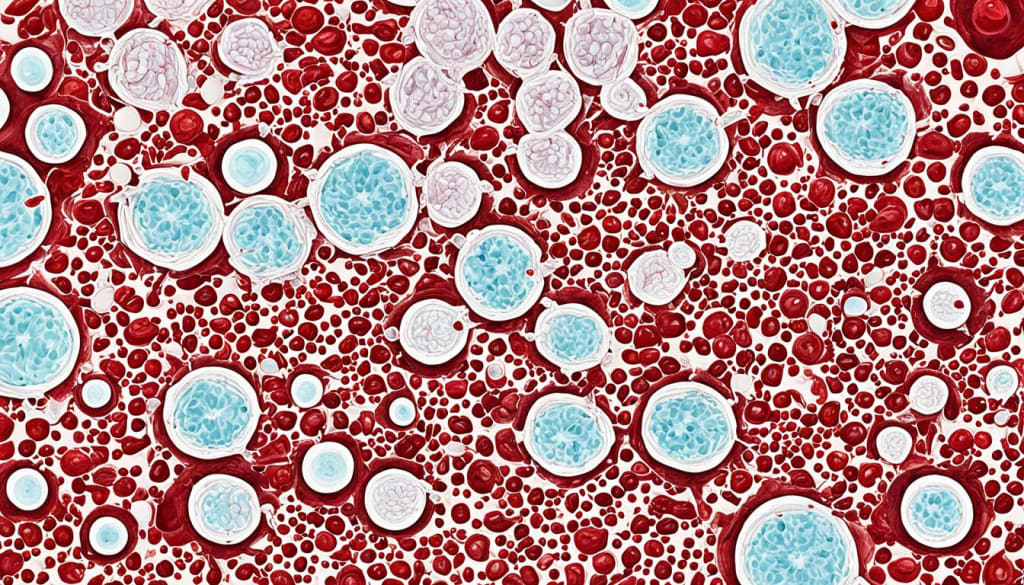Thalassemia: Understanding the Blood Disorder Detail
The Blood Disorder In Detail

Thalassemia is a blood disorder passed down from parents. It causes the body to make less hemoglobin. Hemoglobin is what carries oxygen in red blood cells. When there's not enough hemoglobin, a person can feel tired and weak. There are different types of thalassemia. The type and how bad it is will decide what symptoms you might have.
This disorder happens because of changes in the genes. These changes affect how the body makes the alpha and beta globin chains. They are the parts of hemoglobin. Some people might not show any signs. Others might need blood from donors often or even have to get new stem cells. Thalassemia can cause problems like too much iron in the blood, infections, and troubles with the heart and bones.
Doctors can find out if you have thalassemia with blood tests. The treatments could be getting more blood, drugs to remove extra iron, or in some cases, a new stem cell transplant. There's a way to live well even with thalassemia, by taking care of yourself. This means eating well, not overdoing it, and taking the right kinds of exercises.
What is Thalassemia?
Definition and Overview
Thalassemia is a genetic blood disorder. It affects how red blood cells make hemoglobin. Hemoglobin carries oxygen in our blood. In thalassemia, there's not enough hemoglobin made. This leads to anemia and other symptoms. The symptoms can be mild or severe.
Types of Thalassemia
Thalassemia comes in two main types: alpha thalassemia and beta thalassemia. The seriousness of the disease depends on the genes affected and how many are faulty. Alpha thalassemia affects the alpha globin genes. Beta thalassemia comes from problems in the beta globin genes. People with thalassemia might show no symptoms or have severe, even life-threatening forms of anemia.
Causes of Thalassemia
Thalassemia comes from genetic mutations that change how our body makes alpha and beta globin chains. These chains are key parts of hemoglobin. This issue is passed from parents to children, so it's an inherited problem.
Genetic Mutations
Alpha thalassemia changes the alpha globin chain genes. On the other hand, beta thalassemia alters the beta globin chain genes. The effect of thalassemia can be mild or severe. It all depends on how many faulty genes a person gets from their parents.
Alpha and Beta Globin Chains
Having one or more mutated genes can lead to mild or severe thalassemia. Or, a person might show no symptoms but still carry the condition. The type and seriousness of thalassemia is greatly influenced by the genes someone inherits.
Symptoms of Thalassemia
Thalassemia symptoms vary in their intensity, from mild to severe. This depends on the type and how serious it is. People with a mild case might not show any signs or just feel a bit tired due to mild anemia.
Mild Symptoms
If someone has a single mutated gene for alpha-thalassemia, they might not notice any symptoms. Yet, if they have two missing or faulty genes, a condition known as alpha thalassemia minor, they could face mild effects.
Moderate Symptoms
For moderate thalassemia cases, issues like slow growth, late puberty, and bone problems can arise. People with three missing or faulty alpha genes, seen in Hemoglobin H disease, often experience more serious symptoms.
Severe Symptoms
The severe types, like Hemoglobin H disease and beta thalassemia major, show serious anemia signs. Babies or toddlers might have low energy, yellow skin (jaundice), dark urine, and weird face bones. Very rarely, complete alpha gene absence causes hydrops fetalis. This can be fatal without constant blood transfusions.
Risk Factors for Thalassemia
Are you worried about thalassemia? The risk is higher if thalassemia runs in your family or if you’re from certain parts of the world. This condition is passed down from parents to children. So, if your family has thalassemia, you might get it too. Thalassemia is more common in African American, Mediterranean, and Southeast Asian people. They have more of the genes that lead to thalassemia.
Family History
If your parents or relatives have thalassemia, you’re more likely to get it. This is because thalassemia can be passed on through genes. Knowing your family’s health history is crucial. It helps in understanding your risk of thalassemia.
Ancestry
Thalassemia is often found in people from specific areas and ethnic backgrounds. These include parts of Africa, the Mediterranean, and Southeast Asia. The risk increases for those with family roots in these places. Knowing where your family is from can give clues about your thalassemia risk.
Complications of Thalassemia
Thalassemia is a genetic blood disorder that can lead to several serious issues. A key problem is iron overload. This happens because of the disease itself or the need for many blood transfusions. Too much iron might harm the heart, liver, and hormonal balance.
People with thalassemia are more likely to get infections, particularly if their spleen has been taken out. They might also face bone deformities, like a big or oddly shaped head. Their bones could become thin and fragile because of excessive marrow production.
If the spleen swells up, it can make anemia worse and shorten how long transfused blood lasts. In severe cases, the spleen might have to be removed. Thalassemia can also inhibit a child's growth and postpone puberty. It raises the chances of heart problems, like heart failure and irregular beats, too.
Diagnosis of Thalassemia
Diagnosing thalassemia starts with a series of blood tests. These tests figure out the specific type of thalassemia. They also show how severe the condition is. One key test is a complete blood count. It measures hemoglobin levels. Another is hemoglobin electrophoresis. This test looks at the different hemoglobin types. Genetic testing may also be used. It finds the genetic mutations causing thalassemia.
If thalassemia might be present in an unborn baby, prenatal testing is an option. Test results, symptoms, and family history combine to help doctors diagnose thalassemia accurately.
These tests, along with medical history and symptoms, help doctors make an accurate diagnosis of thalassemia. Then, they can create the right treatment plan.
Treatment Options for Thalassemia
People with thalassemia can choose from several treatments based on their type and seriousness. One common option is blood transfusions. These raise the amount of healthy red blood cells and hemoglobin. Yet, too many transfusions can cause another problem. This problem is too much iron in the body. To deal with this, iron chelation therapy is needed.
Blood Transfusions
For those with moderate to severe thalassemia, blood transfusions are key. They help fill up the body with necessary, healthy red blood cells. This is important for carrying oxygen around the body. If you have beta thalassemia major, you may need blood transfusions every 3 to 4 weeks to keep your blood healthy.
Iron Chelation Therapy
To avoid too much iron from the extra blood, iron chelation therapy is used. It stops iron from harming the heart, liver, and other organs. You may take drugs like Deferasirox, Deferiprone, or Deferoxamine for this. Their side effects can differ, though.
Stem Cell Transplantation
In very severe cases, a stem cell transplant might be possible. This is also called a bone marrow transplant. It swaps out damaged bone marrow with healthy ones. The aim is to boost the production of hemoglobin. If successful, it can lower the need for more blood transfusions. Yet, not many with severe thalassemia can have this option.
Living with Thalassemia
It's possible for people with thalassemia to lead a good life by taking certain steps. It's key to manage tiredness well, as this is often a big issue for them.
Managing Fatigue
Dealing with tiredness involves getting enough sleep and not doing too much in a day. It's important to find ways to save your energy. By alternating between activity and rest, the effects of tiredness can be reduced.
Dietary Recommendations
Eating a diet full of important nutrients is advised for those with thalassemia. This means getting enough iron, folic acid, and vitamins that help make healthy blood cells. It's also suggested to avoid too much iron to prevent problems like iron overload.
Exercise and Activity
Staying active is good for people with thalassemia because it boosts fitness and happiness. But, it’s crucial to talk with a doctor before starting any new exercise. This step ensures the workout plan is safe and fits their health needs, especially if they have joint issues or complications.
Prevention and Genetic Counseling
Thalassemia is usually passed down and can't be prevented. But, people can lower the chance of giving it to their kids. Genetic counseling helps those with thalassemia or the carriers. They learn about the risks and family planning choices like assisted reproductive technology with preimplantation genetic diagnosis.
In India, 3% to 4% of the people are thalassemia carriers. There are 270 million carriers worldwide, with 80 million having β-thalassemia. 3,00,000 to 4,00,000 babies are born with these diseases every year.
About 23,000 newborns have β-thalassemia major, mainly in poor families. It's crucial to use genetic advice and new technologies to fight thalassemia in these places.
The numbers show thalassemia's huge impact, especially in poor areas. We must use all available methods, like genetic counseling and assisted reproductive technology, to fight this disorder.
About the Creator
Enjoyed the story? Support the Creator.
Subscribe for free to receive all their stories in your feed. You could also pledge your support or give them a one-off tip, letting them know you appreciate their work.





Comments (1)
Good work. I am thinking about writing articles about nursing and I have a few topics already lined up mainly dealing with Pathophysiology.